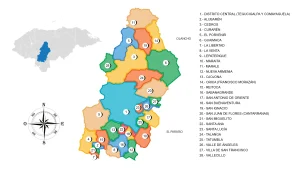Municipality of Yoro
The municipality of Yoro is located in the department of Yoro in Honduras. It is the head of the department.
The word «Yoro» means «center heart» in Spanish.
Location
The municipality borders the municipalities of Tela, Arizona, Esparta, and La Masica to the north, Victoria, Yorito, Marale, and Mangulile to the south, Jocón and Olanchito to the east, and Victoria and Morazán to the west.
History
It seems that the original name was «Hacienda del oro» (Gold Estate); then in 1774, it was named «Santa Cruz de Yoro,» and later «Villa de Santiago de Yoro.» In 1791, it was the head of the Yoro curacy. On June 28, 1825, in the first political division of Honduras, Yoro was designated as the departmental head, and on March 10, 1852, President José Trinidad Cabañas granted it the title of city. In the Territorial Political Division of 1889, it was a district composed of the municipalities of Yoro, Rosa or Siriano, Yorito, and Jocón.
Villages
The municipality consists of the following 19 villages:
Yoro, Ayapa, Chalmeca, Guare, La Capa, La Guata, La Laguna, La Laguna de La Capa, La Rosa, La Trinidad, Las Quebradas, Locomapa No.1, Locomapa No.2, Mejía, Nueva Florida, San Diego, San José de Texiguat, Subirana, and Tulanguare.
Yoro Background
The culture of the departmental head city is strengthened by the natural phenomenon of the Rain of Fish, which occurs every year as a «celestial miracle,» as specified in the local folklore, including the Honduran national song, the Corrido Nacional de Honduras. A strong rumor or murmur spreads from mouth to mouth among the people of Yoro during June each year, and with the first rains of the season, everyone talks about the falling of silver fishes.
In a recent sports report dedicated to Honduras for the 2014 Brazil World Cup, FIFA includes a brief message about the phenomenon of the Rain of Fish that captivates locals and foreigners.
The city of the Rain of Fish, Yoro, is the birthplace of the indigenous Xicaques or Tolupanes, whose settlements are mainly found in this municipality and the nearby ones of Yorito, Victoria, Jocón, and Orica in the central-northern region of the Central American country.
Honduran Tolupanes stand out from other national ethnic groups due to their passivity and subtlety in addressing their issues. Some experts in their way of life presume that this characteristic of the ethnic group is due to their economic heritage, as they are owners of large land holdings, including valuable pine forests included in their land deeds approved by the State at the instigation of their defender and advisor, Spanish missionary Manuel de Jesús Subirana.
On the same topic of the Xicaques, the Honduran Institute of Anthropology and History has an ongoing important request to UNESCO to recognize the oral traditions and the Tol dialect of the Tolupanes as a World Heritage Site.



